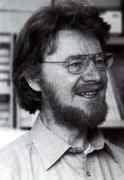Person: Bell (3), John

John Stewart Bell was an Irish mathematician who worked in quantum mechanics.
Mathematical Profile (Excerpt):
- Bell was able to show that discussion of such concepts as 'realism', 'determinism' and 'locality' could be sharpened into a rigorous mathematical statement, 'Bell's inequality', which is capable of experimental test.
- Indeed, almost wholly due to Bell's pioneering efforts, the subject of quantum foundations, experimental as well as theoretical and conceptual, has became a focus of major interest for scientists from many countries, and has taught us much of fundamental importance, not just about quantum theory, but about the nature of the physical universe.
- In addition, and this could scarcely have been predicted even as recently as the mid-1990s, several years after Bell's death, many of the concepts studied by Bell and those who developed his work have formed the basis of the new subject area of quantum information theory, which includes such topics as quantum computing and quantum cryptography.
- John Stewart Bell's parents had both lived in the north of Ireland for several generations.
- Bell himself was interested in books, and particularly interested in science from an early age.
- Unfortunately the cost of attending one of Belfast's prestigious grammar schools was prohibitive, but enough money was found for Bell to move to the Belfast Technical High School, where a full academic curriculum which qualified him for University entrance was coupled with vocational studies.
- Bell then spent a year as a technician in the Physics Department at Queen's University Belfast, where the senior members of staff in the Department, Professor Karl Emeleus and Dr Robert Sloane, were exceptionally helpful, lending Bell books and allowing him to attend the first year lectures.
- Bell was able to enter the Department as a student in 1945.
- Bell was already thinking deeply about quantum theory, not just how to use it, but its conceptual meaning.
- At the conclusion of his undergraduate studies Bell would have liked to work for a PhD.
- Mary was to stay in accelerator design through her career; towards the end of John's life he returned to problems in accelerator design and he and Mary wrote some papers jointly.
- Accelerator design was, of course, a relatively new field, and Bell's work at Malvern consisted of tracing the paths of charged particles through accelerators.
- Bell's work was masterly.
- In 1951 Bell was offered a year's leave of absence to work with Rudolf Peierls, Professor of Physics at Birmingham University.
- During his time in Birmingham, Bell did work of great importance, producing his version of the celebrated CPT theorem of quantum field theory.
- Unfortunately Gerhard Lüders and Wolfgang Pauli proved the same theorem a little ahead of Bell, and they received all the credit.
- However, Bell added another piece of work and gained a PhD in 1956.
- Bell published around 80 papers in the area of high-energy physics and quantum field theory.
- The most important work was that of 1969 leading to the Adler-Bell-Jackiw (ABJ) anomaly in quantum field theory.
- This resulted from joint work of Bell and Ronan Jackiw, which was then clarified by Stephen Adler.
- While particle physics and quantum field theory was the work Bell was paid to do, and he made excellent contributions, his great love was for quantum theory, and it is for his work here that he will be remembered.
- They were therefore pleased when John von Neumann proved a theorem claiming to show rigorously that it is impossible to add hidden variables to the structure of quantum theory.
- Bell regarded himself as a follower of Einstein.
- Bell thus supported realism in the form of hidden variables.
- In 1964, Bell made his own great contributions to quantum theory.
- However Bell then demonstrated certain unwelcome properties that hidden variable theories must have.
- Bell had showed rigorously that one could not have local realistic theories of quantum theory.
- The other property of hidden variables that Bell demonstrated was that they must be contextual.
- John Clauser, Richard Holt, Michael Horne and Abner Shimony adapted Bell's work to give a direct experimental test of local realism.
- Bell has reached what has been called experimental philosophy; results of considerable philosophical importance may be obtained from experiment.
- The Bell inequalities have been tested over nearly thirty years with increasing sophistication, the experimental tests actually using photons with entangled polarisations, which are mathematically equivalent to the entangled spins discussed above.
- For the rest of his life, Bell continued to criticise the usual theories of measurement in quantum theory.
- Bell himself became a Fellow of the Royal Society as early as 1972, but it was much later before he obtained the awards he deserved.
- John Bell died suddenly from a stroke on 1st October 1990.
Born 28 July 1928, Belfast, Northern Ireland. Died 1 October 1990, Geneva, Switzerland.
View full biography at MacTutor
Tags relevant for this person:
Origin Ireland, Physics
Thank you to the contributors under CC BY-SA 4.0! 

- Github:
-

- non-Github:
- @Andrew-Whitaker
References
Adapted from other CC BY-SA 4.0 Sources:
- O’Connor, John J; Robertson, Edmund F: MacTutor History of Mathematics Archive
